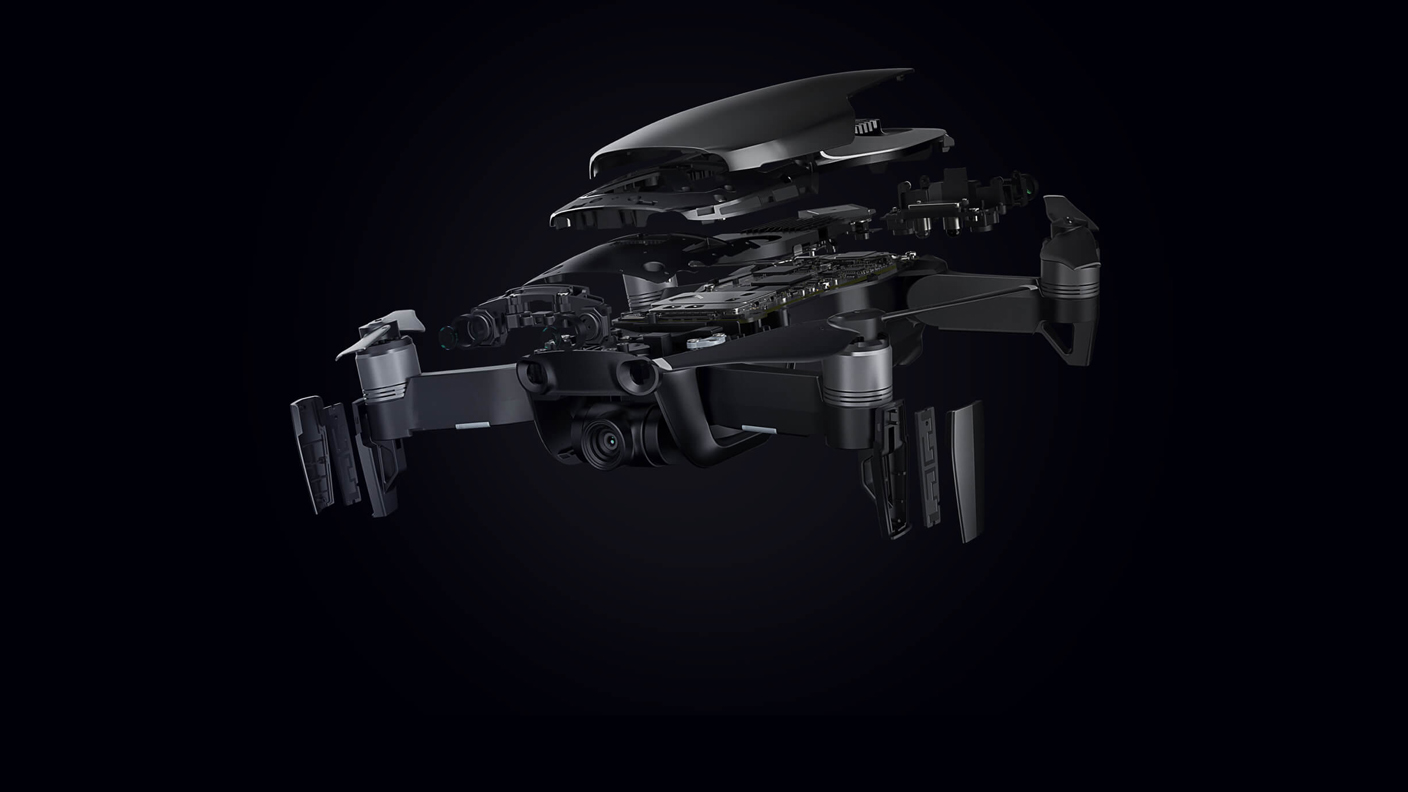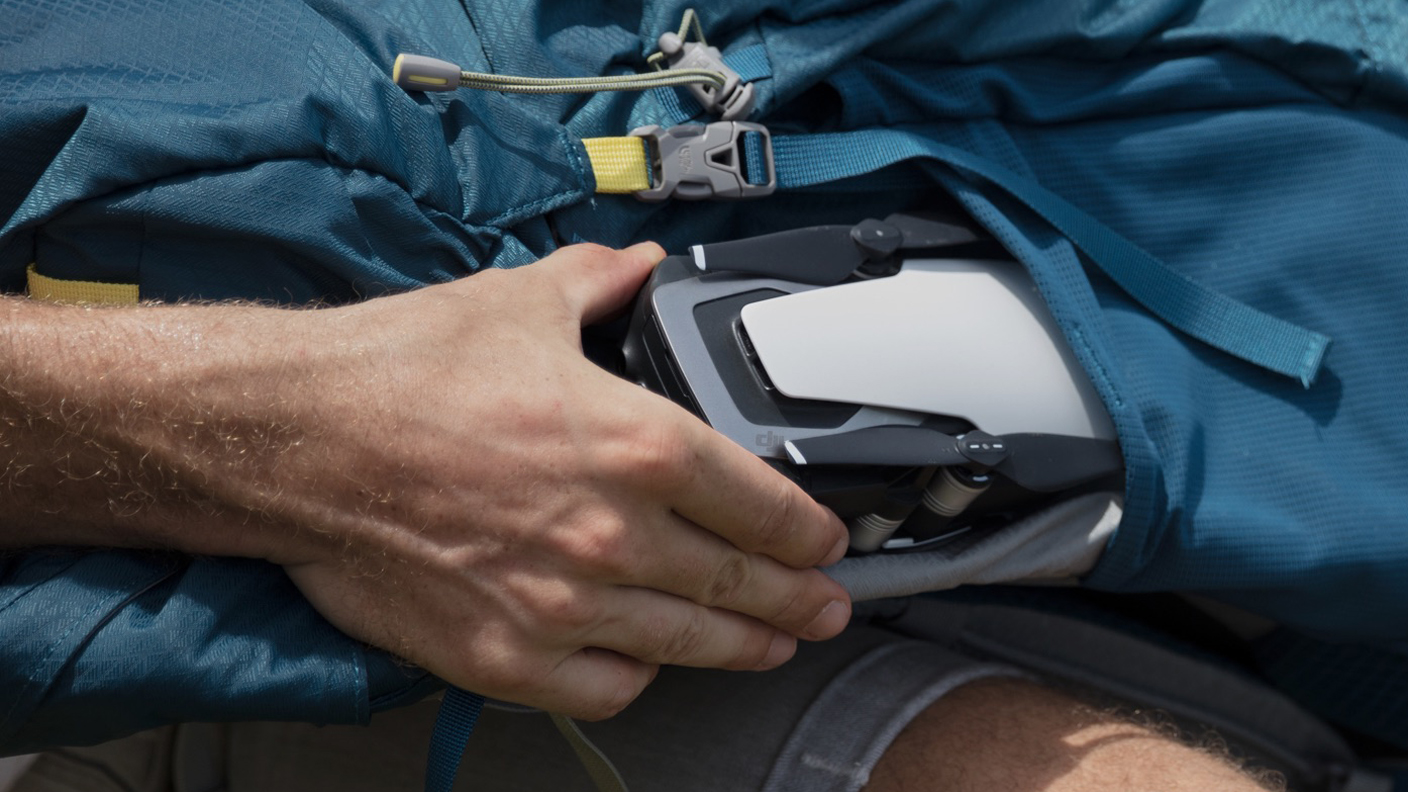DJI has officially announced its latest drone, the Mavic Air. This travel-friendly, 4K-ready drone is positioned to take the spotlight from other drones in the consumer space with impressive performance and a portable form factor.
But, there’s still the Mavic Air’s bigger and pricier older brother, the Mavic Pro, to consider. Here, we’ll look at how the two DJI drones stack up against one another to determine if there’s a solid reason to choose one over the other, so you can rest assured you’ve made the right choice if you buy one.
Specs

We’ll start by taking a look at the specs of each device as they relate to cameras, sensors and storage.
The new Mavic Air packs a 1/2.3” CMOS image sensor that can capture 12MP stills with HDR or create 32MP spherical panorama shots. The camera is capable of shooting 4K video at 30fps, 2.7K video at 60fps and Full HD video at 120fps. It’s recording can operate at a fast 100Mbps bitrate, packing a lot more information into the video. The camera system has an 85-degree field of view and is supported by a 3-axis gimbal for stable shooting.
The Mavic Pro’s camera system is comparable to the Mavic Air’s, but there are some differences. The Mavic Pro also supports its camera on a 3-axis gimbal, but it only has a 78.8-degree field of view. Its camera can also snap 12MP still images and shoot 4K video at 30fps. However, to hit 120fps, it has to shoot at 720p, and it can’t capture HDR images. It does get a leg up in professional video applications, though, as it can shoot in cinematic 4K (a higher resolution version) at the industry-standard 24fps. The Mavic Pros video bitratre is a bit slower than the Mavic Air’s, coming in at 60Mbps.
The Mavic Air edges out the Mavic Pro in terms of sensors, with more packed on to keep the drone flying safe and avoiding obstacles. However, the Mavic Pro takes that edge back when it comes to operational distance, as it is capable of communicating with the controller up to 4.3 miles away compared to the Mavic Air’s 2.5-mile functional range.
While both drones support microSD cards, the Mavic Pro supports a 64GB maximum that doesn’t do much to compete. The Mavic Air can support a 128GB microSD card, and it also has 8GB of internal storage for those times you need a picture or video in a hurry.
Design and portability

The designs of the Mavic Air and Mavic Pro are fairly similar. Both feature foldable propeller arms coming off the corners of a long, rectangular body. Both also have a camera mounted in the front. The Mavic Pro’s camera is more open, while the Mavic Air’s camera is slightly nestled into the chassis.
Where the drones differ most in design is in their respective sizes. The Mavic Air is roughly half the size of the Mavic Pro, and it’s 41% lighter. The Mavic Pro weighs in at 1.62lbs (734g) while the Mavic Air is just 0.94lbs (430g). The Mavic Air is just as wide as its big brother, but it’s shorter and shallower. The Mavic Pro measures 7.79 x 3.26 x 3.26 inches (198 x 83 x 83mm), while the Mavic Air measures a pocketable 6.61 x 3.26 x 1.92 inches (168 x 83 x 49 mm).
The bottom line is that the Mavic Air is by far more portable. At DJI’s launch event, the presenter even made a point of this by carrying his phone, wallet, and three DJI Mavic Air drones in the pockets of his vest, along with the wireless controller in his back pocket. To up the portability even further, the controller has removable thumbsticks to reduce its profile.
Flight and control

While we’ve already mentioned that the Mavic Pro has a greater range than the Mavic Air, that’s not the end of the story when it comes to flight and controls.
Both the Mavic Pro and Mavic Air come with remote controls and support DJI Goggles for a first-person flying perspective. On these points, the two are evenly matched.
The Mavic Air sports a 2,375mAh battery that can support 21 minutes of fly time. The Mavic Pro boasts a large 3,830mAh battery that gets it up to 27 minutes of fly time. In terms of total flight distance possible with each drone, the Mavic Air can go 6.2 miles (10km) without wind on a single charge, while the Mavic Pro can go 8 miles (13km).
The Mavic Air is a bit zippier than the heavier Mavic Pro. It can top out at 42.5mph (68.4km/h) compared to the Mavic Pros top speed of 40mph (65km/h) in sport mode. Both are a match in terms of how they handle wind, with each capable of resisting 19-24mph (29-38km/h) winds.
The controls of each drone are where the two start to diverge a bit more. While each can be controlled with a phone or with the included remote control, they can also be controlled with a pilot’s bare hands in a number of ways via gesture controls. And those gesture controls have been upgraded in the Mavic Air.
Both the Mavic Air and Mavic Pro support the autonomous SmartCapture modes called Rocket, Dronie, Circle and Helix – each a flight pattern for the drone to automatically shoot a quick video. Now, though, the Mavic Air has added on Asteroid and Boomerang. Boomerang sends the drone out and away in an arc, then it circles back, returning to the pilot like a boomerang. Asteroid has the drone fly out to create a spherical panorama merged with video as the drone flies back toward the subject.
The Mavic Air’s improved sensors can also help it fly smarter while being piloted in any of its control modes. Instead of stopping when moving toward an obstacle like older DJI drones, it will create a flight path around the obstacle and continue in the direction it was going. It also takes the lead in DJI’s “ActiveTrack” mode, which has it follow a subject and keep it in the center of the shot. ActiveTrack with the Mavic Pro works by drawing a box around the subject the drone is supposed to follow, but with the Mavic Air, the pilot can just click on the subject to track. Plus, the Mavic Air can even follow multiple subjects.
All in all, the Mavic Air appears to top the Mavic Pro in terms of flight capabilities and controls, even if it cannot go as far or for as long.
Price and release date

The Mavic Pro has a base price of $999 (£1,099 / AU$1,599), which includes the controller and an extra pair of propellers, along with a number of other cables for connecting and charging.
The Mavic Air comes in lower at $799 (£769, AU$1,299) while still including a controller, two extra pairs of propellers, the necessary cables, and it adds in a set of propeller guards, a carrying case and spare thumbsticks for the controller.
The Mavic Air is available for pre-order now, and it’s expected to ship on January 28. The Mavic Pro has been available for some time, and it can be ordered here.
Conclusion

While we'll have to wait for a full Mavic Air review to truly compare these two fliers, the new drone already looks to top the Mavic Pro in a lot of areas while coming close in others. Plus, the substantial difference in price will likely put the Mavic Air well ahead of its big brother for most buyers.
Anyone who absolutely needs the slightly increased fly-time and range or the cinematic 4K recording option of the Mavic Pro will probably stick to the older and larger drone, but for everyone else, the Mavic Air is, on paper, a more capable and more affordable option that should be the clear choice. It’s faster and smarter, capable of shooting in new ways, and the $200 savings on price is substantial.
source http://www.techradar.com/news/dji-mavic-air-vs-mavic-pro
No comments:
Post a Comment